Puerto Vallarta Tours by Johann & Sandra Reviews
Puerto Vallarta
Puerto Vallarta is located on the Pacific Coast on one of the largest bays in the world. Banderas Bay measures 42 kilometers from north to s. The northernmost limit of the bay is at Punta Mita which is the end of the Sierra de Vallejo mountains and, to the due south, the bay ends in Cabo Corrientes, office of the foothills of the Sierra del Cuale range.
The bay has been known since the XVI Century when Spanish soldiers, during the expeditions to Lower California (or isle of pearls, as they called it) , landed on the bay�s beaches in order to supply their ships with water, firewood and fresh food. There are many chronicles from that time that mention the dazzler of the coastline, the fertility of the land and the condom harbors that the bay offered ships.
During the XVI Century, safe harbors all along the Pacific Declension were a vital necessity and then that ships returning from the Philippines would accept a place to notice refuge in case of attack by pirates.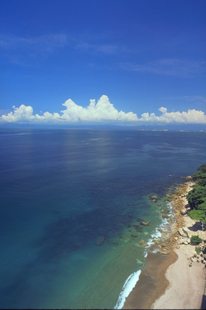
These harbors were also necessary during the long journeys, to and from the Orient so that ships could exist repaired if necessary and crews could take on provisions.
I of the first to propose a settlement on Banderas Bay was Captain Pedro de Unamuno after the trip he fabricated in 1587 from the Philippines.
Famous navigators like Sebastian Vizcaino, Lopez de Vicuna and Gonzalo de Francia more than than one time landed on these beaches and also proposed the institution of a colony, but their petitions never received any attention.
It is known that a shipyard was built on the bay in 1644 (probably where Mismaloya is located today) and 2 ships were built for Bernardo Bernal de Pinadero that would be used in the colonization of Lower California.
In certificate and in ships logs dating from the XVIII Centuries, constant references are made to whaling ships and fishing boast that harbored in the bay. At the time, Banderas Bay was as well known as Humpback Bay (Bahia de los Jorobados) because of the number humpback whales that were seen in the bay.
In the 19 Century, the site that is today Puerto Vallarta was used for the loading and unloading of supplies and materials for the mining companies that worked the mines in Cuale and San Sebastian. At that fourth dimension the site was known equally Las Pe�as.
Around the middle of the XIX Century, Don Guadalupe S�nchez Torres, originally from Cihuatl�n, Jalisco, began to brand regular deliveries of table salt in his small boat since the mines required large quantities for refining the silver. Don Guadalupe and his men built a small lean-to from tree trunks and palm leaves and then that they would have a identify to residual that was out of the sun while the sale was being loaded onto donkeys for transport to the mines.
Towards the cease of 1851, Don Guadalupe decided to bring his family to Las Pe�as de Santa Maria de Guadalupe because he arrived early in the morning hours of December 12, the feast of Our Lady of Guadalupe.
With the inflow of new families, the village grew bit by bit and its economy began to change. While some families brought in salt, others began to devote themselves to agronomics or cattle raising.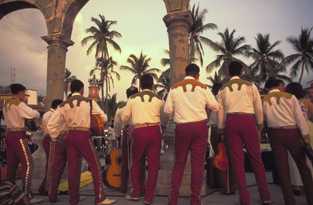
It is as well known that periodically French and German ships entered the bay in search of brazil wood, a very difficult forest that was candy in Europe to obtain dyes. In Admiral George Dewey�southward study to the U.S. Naval Hydrographic Function, he says "on the mouth of a pocket-sized river called the Rio Real (Royal River) is located a small town called Las Pe�equally where the boats come up to take on wood for dyes.
This same admiral, in 1874, aboard the ship Narragansett, fabricated astronomical observations at Punta Mita, Tabo and at a place close to Los Muertos beach in order to establish the exact geographical position of each of these sites and to make a map of the coast.
In 1880, Las Pe�every bit had a population of 1,500 inhabitants. New families from Cuale and San Sebastian came to settle in the port.
V years subsequently, on July 14, 1885, the port was opened to national maritime traffic and officially given the proper name of Las Pe�as. On the 23rd of July, a Maritime Customs Office was established.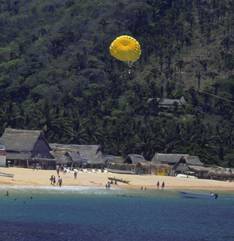
The following twelvemonth on October 31, 1886 the boondocks was given official political and judicial standing when decree No. 210 was passed by the State Congress.
During the last decade of the Xix Century and the outset of XX Century, Las Pe�as gradually progressed thanks to the combined efforts of the people and the enthusiasm of Don Guadalupe.
The inhabitants likewise suffered occasional setbacks in the growth of their boondocks. According geographer Brand, a tidal wave struck Banderas Bay in March 1893, just nobody in town recalls having heard any mention of this consequence. On the 6th of May, 1888, a pot of grease which was being heated over a charcoal fire in a Palapa restaurant, outburst into flame setting fire to the structure. The burn down spread northwards destroying more than one-half the houses in the town. According to local tradition, the burn down would not take done nigh so much harm if half the town�s male population had not been attending a cock fight. In 1911, a waterspout left the almost 100 people homeless and 1922 an epidemic of xanthous fever hit Vallarta causing 150 deaths.
In March 1914, the first post role was opened and in September of the aforementioned year a telegraph was installed.
On May 31, 1918, past Congressional decree No. 1889, the port was elevated to a municipality and the proper noun was changed to Puerto Vallarta in memory of the illustrious lawyer and Governor of Jalisco, Don Ignacio Fifty. Vallarta.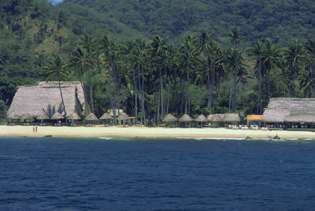
In 1925 when the Montgomery Fruit Company purchased about seventy,000 acres in near-by Ixtapa, Vallarta began to boom due to the surplus of jobs available on the newly-opened assistant plantations. They also built a railway to transport the bananas from Ixtapa to El Salado estuary where they were loaded onto ships to deport them to the United States.
This operation ended in 1935 when the Montgomery Fruit Company had to leave United mexican states because of the new agrarian law that had merely come into outcome. Other products were raised in the surface area such equally corn, beans, tobacco and pocket-size coconuts used for their oil, were shipped to the interior to be used in the national market.
In about 1930, a few national and foreign tourist began to come o Puerto Vallarta, returning year afterward year, to spend their holiday enjoying the serenity and not bad natural dazzler of the port. Slowly word began to spread and each year more tourists came.
In 1951, Puerto Vallarta became internationally known when it celebrated the centennial of its founding. Mexican warships were sent from Acapulco to celebrate the occasion with a 21-gun salute in the bay. A relic of the Truthful Cross was brought to Vallarta also on this occasion and Sra.. Margarita Mantecon de Garza wrote the beginning history of Puerto Vallarta.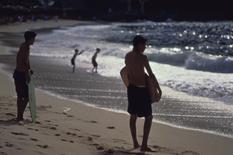
The event that opened broad the doors to progress, popularity and fame was the filming of the movie "Night of the Iguana" in Puerto Vallarta. Thousands of visitors came, broken-hearted to see the places that appeared in the movie and hopeful of catching a glimpse of some of the motion picture stars.
From then on, thanks to the publicity the film gave Vallarta, and as well to the improved ways of transportation, the town grew by leaps and bounds. The town was now accessible by road and past air. First class hotels were congenital. Agriculture, which until at present had been the principal source of income, took a back seat to tourism.
Things have changed since the offset airplane landed here in 1931. Today Puerto Vallarta has hotels that range from minor, economical inns to magnificent luxury hotels. Important national and international airline companies provide services that connect Vallarta to the primary cities of the U.Due south. and Europe. Luxury cruise ships dock here on a daily ground and a good highway connects the town to Tepic, Guadalajara and the rest of the country.
The population growth has been notable. It has gone from 12,500 in 1964 to 250,000 or more in 1988. In that location is a big strange colony, primarily Americans and Canadians, that alive here on a permanent or semi-permanent basis and that are active participants in community life.
Visitors to Puerto Vallarta volition find the climate all twelvemonth around. The average temperature in 80 degrees F., and except for the rainy flavour that lasts from the center of June to the middle of September, the sun shines every day.
All effectually PV, just minutes from downtown, at that place are easily reached areas of nifty natural dazzler, ideal for a day�south outing or a picnic. Some even have there own hotels where information technology is possible for a visitor to "get away from it all" for a few days. Some of the favorite spots are Bucer�as, Mismaloya, Quimixto and Yelapa.
The Federal Government, in conjunction with the country governments of Jalisco and Nayarit likewise every bit some private enterprises, have begun an important program for the evolution of tourism in the unabridged Banderas Bay area.
Puerto Vallarta is the platonic place for anyone who likes water sports. Here i can skin dive, water ski, go deep sea fishing, wind surfing or even try the exciting parasailing.
One of the virtually important annual events in PV is the International Sailfish Tournament held during the commencement week of November. Ardent fishermen from all over Mexico and U.S. participate.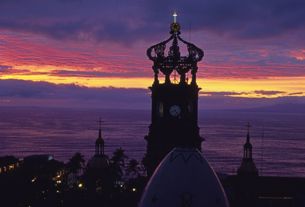
Vallarta is also the site of important conventions and business meetings. Undoubtedly i of the virtually important was the meeting of President Gustavo D�az Ordaz with President Richard Grand. Nixon in baronial, 1970.
This same yr, 1970 , two of import public works were inaugurated: the maritime terminal and the new aerodrome, both of which have been later on remodeled and enlarged in guild to provide better service.
On May 31, 1968, the fiftieth anniversary of Puerto Vallarta�south elevation to a municipality, with Lic. Francisco Medina Ascencio, governor of Jalisco, and Sr. Jose Vazquez Galvan as mayor of Puerto Vallarta, the country government by means of decree No. 8366 elevated PV to the status of a urban center.
Today, Puerto Vallarta occupies an important position amid the rest of the world�s international tourist resorts.
For more information nigh our experiences in Puerto Vallarta, bank check out:
Puerto Vallarta Photo Gallery - Photos from our trip to Puerto Vallarta
Puerto Vallarta Directory - Links to everything Puerto Vallarta
Puerto Vallarta Airdrome - Guide to the Puerto Vallarta International Airport
Source: https://www.johann-sandra.com/vallarta.htm
0 Response to "Puerto Vallarta Tours by Johann & Sandra Reviews"
Post a Comment